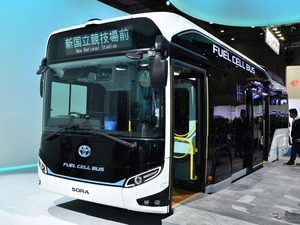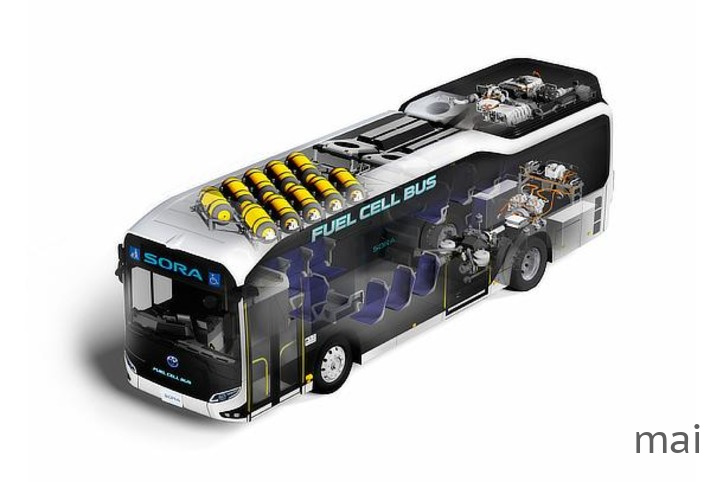Hydrogen games

Nowadays electric omnibuses are unlikely being surprising for anybody all over the world. Moscow booked 200 of them, but public transport using hydrogen is still exotic. Japanese one.
Not all people will remember that the priority in the field of creating hydrogen vehicles belongs to the Soviet Union. In the distant 1976 on the roads of Russia the experimental “Moskvich 412” began to roll out. It necessarily fueled up by… ordinary water!
Different approaches
Like, here it is – the bright future! The vehicle works on water fuel. What we need more? However, everything turned out more complicated. Unfortunately, the experiments did not get very far. The reason for stopping work was the electrochemical method of decomposing water into hydrogen and oxygen, which at that time was not perfect (its efficiency left much to be desired). In addition, there was a possibility of hydrogen leakage, which, if it interacted with the hot internal combustion engine (ICE), could lead to an explosion.
In approximately the same time specialists tried to find another way to use hydrogen differing from burning it in internal combustion engine. That’s how the notorious fuel elements appeared. A power plant based on them regulates in the opposite manner with hydrogen is a storehouse of energy (aka an accumulator), and interacting with oxygen in fuel cell hydrogen develop electricity which in its turn makes all the necessary work. It should be noted RAF minibus for the first time in the world equipped with such a device also appeared in the USSR in the early 80s.

In the shadow of five rings
Future Olympic Games in Tokyo translates into a solid motive for creative solutions as well as all the high-profile events. For example, before the FIFA World Cup 2018 started, Government of Moscow has launched “Moya Ulitsa” (“My Street”) project. Center of the capital was disturbed consecutive four summers. Actually, the result was pretty good as the city looks civilized and well maintained. Japanese decided to go the other way: they concerned the public transport to be ecological by 2020.
The first electrobus on the fuel elements was shown in 2003. It was created on the base of a casual city bus Hino Ribbon City. In the new decade Toyota has grasped this idea. In 2015, the Fuel Cell Bus model working on the same fuel elements was represented. In fact, this happened after the presentation of the serial Toyota Mirai set into motion by the same powertrain shall. So, in the run-up to the Olympic Games in Tokyo Japanese represented another new product that was a waterbus Toyota SORA. SORA is abbreviation (oh, this buzzword, acronym) consists of such English words as Sky, Ocean, River and Air. It is a kind of a symbol to the natural water cycle as the clear message of the hydrogen base of this new vehicle.
Fuel elements base
SORA is constructively simple enough as it is based on the same FCHV-Bus of the Hino bus of 2003. As British say the devil is really in the details. Compare with the firsthand the amount of hydrogen cylinders, put on the roof of the front cabin, has increased from five to ten, and their total capacity has also increased from 150 liters up to 600 liters! Then the first question is if the volume of these cylinders has increased? Far from it! Such an increase was achieved solely by the growth of pressure: from 35 MPa to 70 MPa, and in cylinders of the same dimension.
Over the middle door (again on the roof) there are two fuel-cell units of the TFCS (Toyota Fuel Cell System) each of which has productivity of 114 kW. These blocks known as FC Stack include solid electrolyte based on polymers. The oxygen that must react with the board hydrogen extracted from the air, pumped by the overhead fans, through a high-voltage converter.
Electricity power generated at fuel cells supplies a pair of DC induction motors that output 113 kW of power and develop a total torque of 770 Nm. Tellingly, the motors are embedded inside the rear axle hubs which is greatly saved the underground waterbus space.
Unfortunately, SORA is ideal public transport in spite of the resulting savings. The thing is that because of the need to hide power boosters and control units somewhere, the design turned out to be semi-low-floor, which does not quite meet the requirements of modern urban public transport. However, there is no need to say that this electro omnibus working on fuel cells doesn’t correspond to its function. It seats about hundred passengers from which 22 of them could sit on highly comfortable chair-seats. Some of them are made in the form of strapontins located along the side of the central storage area, which potentially increases the capacity of the passenger compartment. By the way such decision is very innovative for Japan.
Intellectual board
Anyway SORA is not fuel elements. The waterbus is literally filled with different electronic systems and intellectual assistant programs. So, one of them somehow offset the disadvantage we discussed before. It is about automatic steering control, as well as slowing down when the electric bus arrives to a station. This device makes it possible to stop at the landing site of passengers with a clearance of 3-6 cm from the curbstone and observe the distance to the vehicle ahead of the vehicle with an accuracy of 10 cm. Furthermore, eight cameras of high resolution track environment possible around in a mode of real time.
If we talk about the intellectual assistant program then we should mention SORA is equipped with ITS Connect (Intelligent Transportation System) which allows the electrobus to communicate with its road companions, as well as track infrastructure. It tracks acceleration and braking of near cars, which allow withstanding line speed during the route and using control systems of traffic lights PTPS (gives priority to buses).
At the moment, it is known that the first installment of electric buses Toyota SORA on fuel cells with a capacity of 100 units will be delivered this year and will be put on regular service in the center of Tokyo. Subsequently, the cars of this brand will serve other cities of the Land of the Rising Sun, in which the Summer Olympic Games of 2020 will be held. However, one question remains open if this kind of public transport will receive further development or it is a one-off event timed to a great sports holiday? Time will tell.
Actually, fuel cells are the accumulators, but unlike galvanic couples, they have supply source for active substances that are always oxygen and hydrogen. Therefore the energy reserve in them is regulated exclusively from the outside, while the classical battery is forced to increase in size and weight in order to increase it (the reserve). The mechanism of action looks approximately like this: on a catalyst (usually platinum) anode, molecular hydrogen dissociates, as a result of which cations leak through the proton exchange membrane (which is the so-called polymer electrolyte) to the cathode. Electrons that are blocked by the membrane, go into the external circuit. In turn, on the cathode catalyst, hydrogen protons coming from the anode are connected with oxygen molecules and electrons coming from the external circuit. As a result of all this action, water is formed (naturally, in the form of steam). To the pluses of fuel cells can be attributed quite high efficiency - about 80%. Such an indicator is achieved due to the lack of a combustion process (unlike heat engines). In shortcomings, it can be necessary to create a complex infrastructure for the production and storage of high purity hydrogen gas.